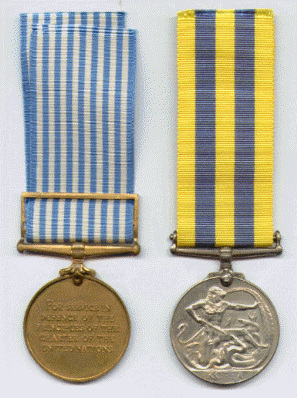A Badge and Two Medals

 MK comments: All of you will recognize the
Union Jack flying here on your right, and some of you guys in our
Bunker will recognize, on your left, the Argyll and Sutherland beret badge. This badge was
proudly worn on the beret of Robert Doherty during his time in
the British army before his transfer, when he got to Korea in
April of 1951, to the King's Own Scottish Borderers (as the Argyll and Sutherland was then leaving Korea) for his
service in Korea from then until August of 1952, when the King's Own Scottish Borderers also left Korea and went to
Hong Kong.
MK comments: All of you will recognize the
Union Jack flying here on your right, and some of you guys in our
Bunker will recognize, on your left, the Argyll and Sutherland beret badge. This badge was
proudly worn on the beret of Robert Doherty during his time in
the British army before his transfer, when he got to Korea in
April of 1951, to the King's Own Scottish Borderers (as the Argyll and Sutherland was then leaving Korea) for his
service in Korea from then until August of 1952, when the King's Own Scottish Borderers also left Korea and went to
Hong Kong.
The three photos on
this page were sent to me by John Doherty, Robert's son. He tells
me that it was only after much coaxing that his father finally
sent for the two medals pictured below, which he finally received
many years after he had first been entitled to them.
The information (eyesight
help too) for the two photos below came not only from John, but
also from Reg Kitchener (#41) and from Felix Harrigan, another
KOSB who is a good friend of the guys in our bunker.
All in the Bunker will
recognize the medal with the blue and white ribbon (on the left
in both photos below) as the United Nations Service Medal to which all of us were
entitled. The word Korea is on the bar of the obverse
side (photo below on the left) and the words FOR SERVICE IN DEFENCE OF THE
PRINCIPLES OF THE CHARTER OF THE UNITED NATIONS are on the reverse side (photo
below on the right).


Those in the
Bunker who served in the British armed forces will recognize the
medal with the yellow and blue ribbon (on the right in both
photos above) as The Korea
Medal which was awarded for:
Royal Navy service with 28 days afloat in the
operational areas of the Yellow Sea and Sea of Japan, or one or
more days of shore duty; Army service of at least one day on the
strength of a unit serving in Korea; RAF service of one
operational sortie over Korea or Korean waters, 28 days afloat in
Korean waters, or one or more days on Korean land.
The obverse side
(photo above on the right) has the laureated bust of Queen
Elizabeth II facing right surrounded by the legend ELIZABETH II DEI GRA: BRITT: OMN:
REGINA F: D:+ and the
reverse side has Hercules, armed with a dagger. His left arm is
held out horizontally and holding Hydra, which he is also holding
off with his left leg. The word Korea is in the
exergue. Colin Demaline (#57) has told me (30 Nov 2001) why the
bust of the Queen was "laureled" and not crowned.
Queen Elizabeth became Queen on the death of her father, King
George VI, in Feb 1952 but was not crowned until Coronation Day,
2 Jun 1953. The Korean Medal was sanctioned and struck between
those two dates, i.e. after she became Queen but before she was
crowned.
Here is a
translation of the obverse legend: ELIZABETH II = the
Queen, then and now, of course; DEI = of God; GRA
= gratia = by grace; BRITT = Britain; OMN = omnia = all;
REGINA = reigning Queen; F
= fidea = of the faith; D = defensor = defender; +
= and.
Thus, it
may be read as Elizabeth
II, by the Grace of God, of Great Britain the Reigning Queen and
Defender of the Faith.

Here is
another flame to warm our Bunker. This one is for remembrance of
Robert and all his mates who survived the war but have passed on
before us.
 3rd
Division Page
3rd
Division Page
 IBB
Map and Photo Index
IBB
Map and Photo Index
 Hills
and a River
Hills
and a River
 IBB -
Page Five
IBB -
Page Five
 "Can
Do" Photo Index
"Can
Do" Photo Index


 MK comments: All of you will recognize the
Union Jack flying here on your right, and some of you guys in our
Bunker will recognize, on your left, the Argyll and Sutherland beret badge. This badge was
proudly worn on the beret of Robert Doherty during his time in
the British army before his transfer, when he got to Korea in
April of 1951, to the King's Own Scottish Borderers (as the Argyll and Sutherland was then leaving Korea) for his
service in Korea from then until August of 1952, when the King's Own Scottish Borderers also left Korea and went to
Hong Kong.
MK comments: All of you will recognize the
Union Jack flying here on your right, and some of you guys in our
Bunker will recognize, on your left, the Argyll and Sutherland beret badge. This badge was
proudly worn on the beret of Robert Doherty during his time in
the British army before his transfer, when he got to Korea in
April of 1951, to the King's Own Scottish Borderers (as the Argyll and Sutherland was then leaving Korea) for his
service in Korea from then until August of 1952, when the King's Own Scottish Borderers also left Korea and went to
Hong Kong.

